This week in Conservation Corner we are going to touch on windbreaks. This is the right time of year to be planning one and this article may provide some insight for you to make an educated decision about what kind of windbreak will work best for you in your situation.
Windbreaks Protect, Enhance & Conserve
Windbreaks are plantings of single or multiple rows of trees or shrubs that protect crops, livestock, wildlife or people from wind’s harmful consequences. Historically, windbreaks were planted for a single purpose, such as protecting homes from cold winds or soil from erosive winds.
Today, windbreaks are being used to address numerous other issues and provide a variety of benefits. When properly designed, located and managed windbreaks produce multiple environmental and economic benefits. It is important to remember that not all potential benefits can be realized from every windbreak.
A few benefits of windbreaks are to improve income, provide protection and enhance aesthetics. Whether a grain, vegetable or hay crop, net yields can be increased by 10 to 20 percent in fields with windbreaks.
Livestock experience improved weight gains with lower feed costs. Heating and cooling costs can also be reduced. Living snow fences can be an effective way to control blowing and drifting snow, reduce snow removal costs and accidents. Windbreaks generally add desirable plant variety enhancing the appearances. Windbreaks also screen undesirable views and provide opportunities for protecting and helping sustain wildlife.
Planning Your Windbreak
Windbreak considerations include density, orientation, and height and length. The more solid or dense a windbreak, the greater the wind speed reduction. However, less dense plantings provide protection to a greater distance. Density can be managed by the type of tree chosen, the spacing within and between rows, and the number of rows.
Windbreaks are most effective when oriented at right angles to troublesome winds. To allow for changes in wind direction, windbreaks are often planted in multiple directions — in an L-shape or an arc.
Avoid placement that may interfere with overhead lines, septic systems, buried cable and road visibility. The height determines how far downwind protection will reach. For adequate protection the windbreak must be taller than what is being protected. The length helps determine the total area to be protected.
Species Selection
Final selection of the species of trees and shrubs will vary at each facility and farm site and should be based on: soil type, natural drainage, common wind conditions, annual precipitation, and natural range of each species and site needs.
Designing Your Windbreak
There are designs for windbreaks that can be planned for you by the staff at the conservation districts or the NRCS.
Call to schedule an appointment to get your custom design that will be developed using the factors of your land that affect your windbreak design.
Additional Resources:
Windbreak Videos
Proven Performers for Windbreak Use:
 |
Austrian PineTall tree; grows well on most soils; to 7,000′ elev.; good windbreak species. Proven Performer and highly recommended for multi-row windbreaks in our area to provide height to central row of multi-row windbreak, or single row windbreak where height is needed. |
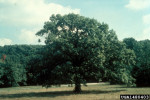 |
Bur OakMedium to tall tree; hardy and drought resistant; tolerant of a wide range of soils; to 7,000′ elev.; good food value for wildlife. Although slow growing, it can be used in multi-row windbreaks for it’s height, density, longevity, wildlife value and fall color. |
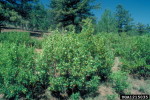 |
CaraganaMedium to tall shrub; grows best on sandy to loamy soils; to 9,500′ Can be used in our area for in the outer rows of multi-row plantings, due to its density, excellent cold hardiness and drought tolerance, although not listed as Proven Performer due to defoliation which can occur in some years due to grasshoppers or blister beetles, disappointing landowner with scraggly look in those seasons – but does recover well from attacks. |
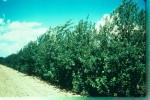 |
ChokecherryMedium shrub with edible fruit; grows well on most soils; to 9,000′ elev. Proven Performer and can be used in multi-row windbreaks in our area to provide windward side density to multi-row windbreaks OR where single row consisting of density and short barrier is desired. |
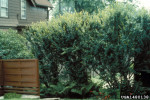 |
CotoneasterMedium shrub; grows well on most soils; to 9,500′. Proven Performer and highly recommended for multi-row windbreaks in our area to provide density to outer rows of multi-row windbreaks. Similar in purpose to the Caragana, but without the tendency to be defoliated by grasshoppers. |
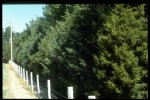 |
Eastern Red CedarMedium, drought tolerant tree; does well on most soils; to 7,500′ elev.; excellent windbreak species. Proven Performer and highly recommended for our area for windbreak use, especially for 1 or 2 row designs, as well in the outer rows of multi-row designs. |
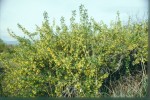 |
Golden CurrantMedium native shrub with bright yellow flowers. Proven Performer for our area, due to sucker sprouting habit and density, recommended for single row, short barriers, or in the windward side of multi-row windbreaks. Provides wildlife value through cover and food. |
 |
HackberryTall tree; grows well on most soils; best at plains elevations; to 7,000′ elev. Proven performer for our area and can be used in middle row of multi-row windbreaks, for height, and/or fall color – use in central row of design. |
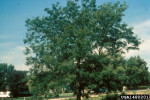 |
Honey LocustMedium to tall tree; grows well on most soils; to 7,500′ elev. Proven Performer for our area, fast grower and excellent species for central row of multi-row windbreaks for it’s height and attractive fall color. |
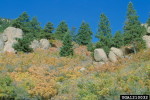 |
Ponderosa PineTall tree; grows well on most soils except for heavy clay; to 9,000′ elev.; good windbreak species. Proven Performer and highly recommended for multi-row windbreaks in our area to provide height to windbreak design for single or high-density twin row windbreaks. |
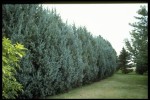 |
Rocky Mountain JuniperMedium, drought tolerant tree; does well on most soils; to 9,000′ elev.; excellent windbreak species. Highly recommended for our area for windbreak use, especially for 1 or 2 row designs. |
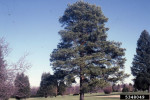 |
Scotch PineTall tree; does well on most soils; to 7,000′ elev.; excellent Christmas tree species. Proven Performer and highly recommended for multi-row windbreaks in our area to provide height to central row of a multi-row windbreak design. |

